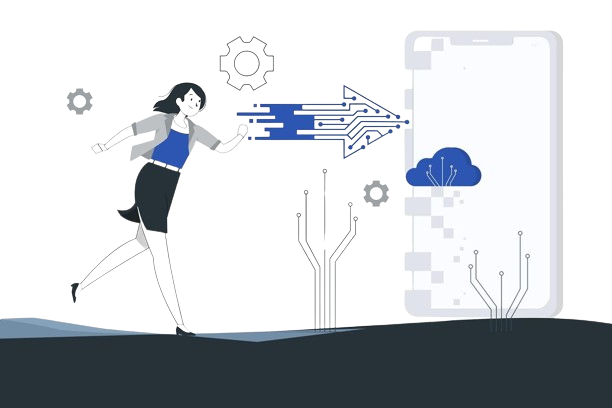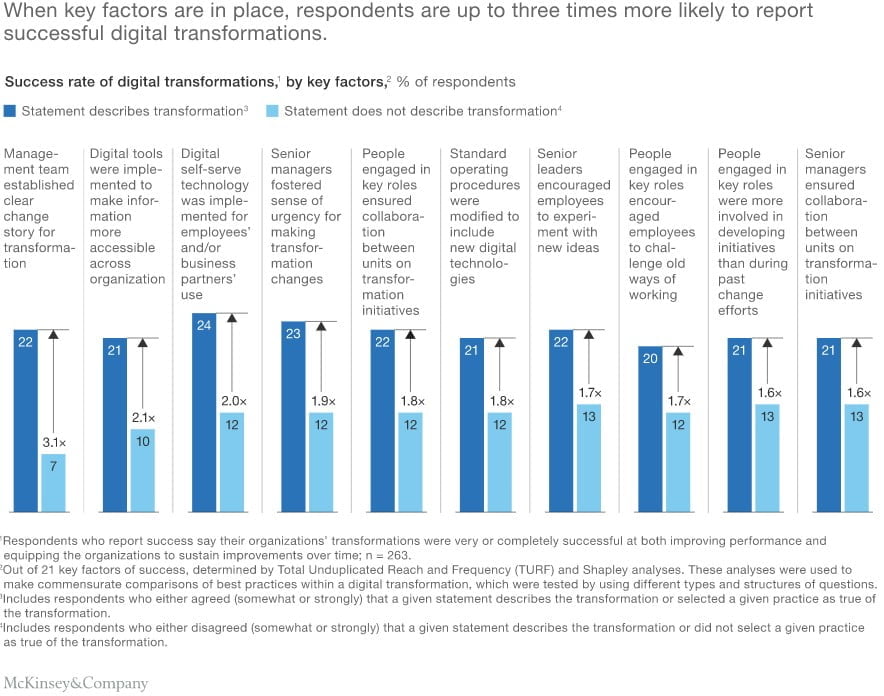Currently Empty: € 0,00


Digital Transformation
Digital transformation is the process of improving a company’s performance by changing how it does business. Besides technology, this process involves organizational, cultural, and structural change.






Why
Digital Transformation
An organization’s operating model changes as a result of digital Transformation. This process involves systems, processes, workflows, and cultures. As a result of this transformation, an organization’s data is brought together across areas more effectively.
- Innovation and competitiveness
- Efficiency and productivity
- Cost efficient
- Sustainabiity
- And more...

People or Tech?
Successful digital transformation depends on both powerful technologies and competent people. It goes beyond a singular digital initiative or employee.

Key success factors
According to a McKinsey study, more than 70% of all digital transformations fail. Success rates vary by industries and company sizes.
Digitally-savvy industries (like high-tech, media, and telecom) have success rates of 24%, while traditional companies only have success rates of 4-11%. Companies with less than 100 employees are 2.7x more likely to report a successful digital transformation than those with more than 50,000 employees.
In summary, the more your company uses technology, and the smaller your company is, the more likely you will succeed in digital transformation. See below for the key factors to successful digital transformation according to McKinsey.

There are many reasons why digital transformations fail, but according to Harvard Business Review, it all comes down to talent.
“The single most important step in digital transformation is assembling the right team who can work together and a strong leader who can bring about change”
There are some key areas where this team should have skills in and focus their efforts on,
- Technology
- Data
- Process
- Change management
- Technology
- Data
- Process
- Change management
While technologies are becoming easier to use, understanding how any particular technology contributes to transformational opportunity, adapting that technology to the specific needs of the business, and integrating it with existing systems is extremely complex. You need people who have technological depth and breadth, and the ability to work hand-in-hand with the business.
Some common problems are:
- Not having an integrated technology
- Picking the wrong technology team for the job
- Implementing new technology onto broken processes
- Underestimating cost and complexity
McKinsey suggests three things:
- Have digital-savvy leaders
- Invest in digital talents
- Upgrade your technology
Most data in many companies today are not up to basic standards:
- Companies are collecting internal data that have never been (and will never be) used
- Companies are not collecting enough external data to make good business decisions
- Companies are not analyzing current available data
- The different data from different departments are not integrated
Most companies know data is important and they know their current data quality is bad, yet they don’t put proper roles and responsibilities in place. They often blame their IT departments for all these failures. By failing to do so, they waste enormous resources.
In order for companies to get better data quality and analytics, they should:
- Create a plan on what data is needed now and what data they will need after the transformation
- Convince people at the front lines to be responsible data customers and data creators
- Improve work processes and tasks that help front liners create data accurately
Beyond these factors, an increase in data-based decision making and in the visible use of interactive tools can also more than double the likelihood of a transformation’s success.
According to Harvard Business Review, transformation requires:
- End-to-end mindset
- A rethinking or ways to meet customer needs
- Seamless connection of work activities
- The ability to manage departments going forward
Therefore, it makes sense to change and optimize processes.
However, traditional hierarchical thinking makes it hard. Therefore, oftentimes, transformation is reduced to a series of incremental improvements — important and helpful, but not truly transformative.
Some common problems are:
- Implementing new technology onto broken systems and processes due to people’s unwillingness to change
- Not being flexible about systems and processes to adjust to new technology
Many companies fail their digital transformations due to their unwillingness to modify their standard operating procedures to fit into the new technologies they are adopting.
When building talents in this domain, look for the ability to:
- Align departments to improve existing processes and design new ones
- A strategic sense to know when incremental process improvement is sufficient and when radical process reengineering is necessary
According to McKinsey, redefining individuals’ roles and responsibilities are crucial to align their goals with the transformation goals (1.5x more likely). By doing so, it helps clarify the roles and capabilities the company needs.
Organizational change capability refers to the ability to introduce change to a company.
Some of the common problems are:
- Poor onboarding process
- People’s resistance to change
- Failing to set clear digital transformation goals
- Miscommunication of the goals
- Not coordinating the goals across teams
- Lack of commitment
- Not having the right skills
- Overestimating benefits and underestimating costs
Some of the skills needed are:
- The ability to listen and communicate clearly and effectively
- High level of emotional intelligence
- Strong organizational skills
- Detail-oriented, problem-solving, and decision-making skills
- Delegating without micromanaging
- Leadership, teamwork, courage
Conclusion
Technology, data, process, and organizational change capability work together. Technology is the engine of digital transformation, data is the fuel, process is the guidance system, and organizational change capability is the landing gear. You need them all, and they must function well together.
A problem in one area will bring problems to other areas, but you can’t blame one area for the failure in another area (although it may be true). The best solution involves the four working together.
It is hard for business leaders to see the full potential of digital transformation due to lack of understanding of each domain, which is one of the contributing factors to many failed digital transformations. Which is why we recommend having talent in each area.
Lastly, work on technology, data, and process must proceed in an appropriate sequence. For most companies, we would recommend the following:
Process → data → technology
There is no point in automating broken processes, so process improvements come first (most of the time). Then you need to be clear on what data you need to analyze, and what data is not important. Then you choose the right technology for your needs.
Although that is the recommended sequence, you still need to be flexible about it. A lot of times, the technology that you choose cannot follow your process or collect the data that you want, in which case you should be willing to make slight adjustments. It is also common that the process your technology can support makes more sense than the process you originally thought ideal. So be open minded about it.
At the end of the day, digital transformation should be focused on problems of greatest need to your company.
For example, if your focus is in fixing your accounting, the data and process talent should have accounting expertise. If your focus is in fixing your human resources, the data and process talent should have human resource expertise. Most importantly, they should have past success at creating and executing any kind of technology-driven transformation.


